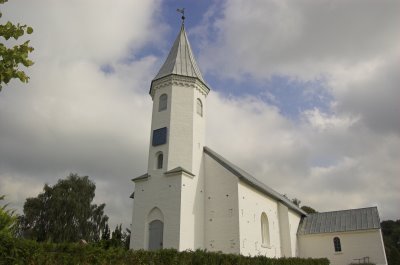
Them Church, ab. 8 km south of Silkeborg
Them sogn, Vrads herred, Skanderborg amt.

The altar piece (and the pulpit) were carved in oak about 1600s.
The church in Them is from the Romanesque period with a later added tower to the west, a porch to the south and a crossarm to the north. The choir and nave is built in granite ashlars. A window is preserved at the north side of the choir, but bricked-up. The south door is outside, its coverstone with cross and rope-windings lie now at the church yard in front of the porch door. The north door is bricked-up and hardly traceable. The choir arch was extended in the late Middle Ages, and in the choir was built one, and in the nave two bays octagonal rib vaults. From a late Gothic monk brick tower was ab. 1775 the upper section removed, the bottom with a board ceiling is connected to the nave in a large pointed arch. A ridge turret for the bell was in 1842 built above the western gable, but was in 1863 replaced with a spire. The porch is from 1872. The entrance is to the east, since a small room has been separated to the south . The porch replaced an earlier porch which from 1672 had a small halftimbered shingled roof. The cross arm with a plaster ceiling was in use from 1875 after the church for a long time had been too small for the congregation. The church has been restored several times.



The frescoes are from the late 1400s. The big picture in the choir arch is virgin Mary with seven swords pointing at her heart. The swords symbolize the sorrows which Christ caused his mother according to ancient tradition .
Rests of late Gothic frescoes from ab. 1500; in the choir arch virgin Mary with seven swords pointing at her heart (Mary's seven sorrows) and upon the vaults rib-decorations and masks. - The communion table is in oak wood with relief from 1893. The altar piece in Renaissance style from the beginning of the 1600s with a painting from 1860 and a new foot piece with relief from 1893. Altar candelabres from ab. 1625. The baptismal font in sandstone was made after professor Bindesbøll's drawing. The old Romanesque granite font from the church is now in Silkeborg church. The pulpit is contemporary to the altar piece, but also re-made in 1893 where three of four original evangelist-pictures were replaced with carved figures. When the pews were re-newed in 1904 several gables were kept from 1585, of which some have carved names. - Upon the church yard a granite gravestone from ab. 1700 in the shape of a tree.
Tømmerby church which was situated about 1/2 km northwest of the present, was desolate in 1592, while the church yard was still in use 1661. The church had a nave and a choir. The length was 19,4, the nave was 9,20 and the choir 7,60 m broad. Granite ashlars have been found at the sitr.
The abbot in Tvis sold 1338 all his estate in Them to hr. Ove Hase. Peder Brok gave in 1339 his estate in Fogstrup to Ring kloster, which his widow confirmed the same year.
Anders Offesen (Hvide) of Torup gave in 1391 Virklund and Hedegård to Århus cathedral, Stig Nielsen of V. 1499 was probably the bishop's vasal.
Listed prehistorics: a dolmen chamber without cover stone at Høvildgård, 2 long hills and 81 hills, rather large are Sortehøj south of Pårup and two hills, which are in a group of 6 southwest of Løgager. Furthermore listed are 2 røser (stone graves); an area with 5 stone graves at Løgager, an area with 9 tuegrave (small earth graves), probably from Iron Age at Rustrup; an area with 14 stone heaps, probably clearing heaps at Hjortsballe; and an area with prehistoric fields, clearing heaps and traces after iron extraction at Fogstrup.
Demolished or destroyed: 4 dolmens and 202 hills., most from Stone Age's single grave-culture. - There are many settlements from the Gudenå-culture in the parish. - A dyssetids (early Stone Age) earth grave with two thin-necked axes, some arrow-heads and amber pearls and a small jewelry-plate in copper were found at Salten Overgård, where was also an important burial site with jordfæstegrave (where the body was placed upon the side) from early Roman Iron Age, a similar burial site was found in Them village. At Sepstrup was examined an urn-burial site from Celtic Iron Age. At Tømmerby was found an bronze statue of a Roman emperor.
Source: Trap Danmark, Skanderborg amt, 1964.

photo Them kirke: stig bachmann nielsen Naturplan foto & grethe bachmann
No comments:
Post a Comment